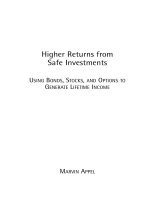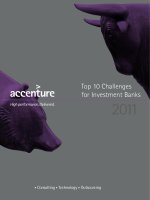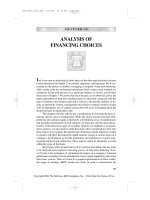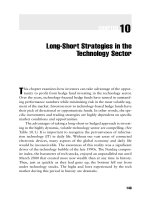Chapter 10 making capital investment decisions
Bạn đang xem bản rút gọn của tài liệu. Xem và tải ngay bản đầy đủ của tài liệu tại đây (233.75 KB, 33 trang )
Chapter 10
Making Capital
Investment
Decisions
McGraw-Hill/Irwin
Copyright © 2010 by The McGraw-Hill Companies, Inc. All rights reserved.
Key Concepts and Skills
•
Understand how to determine the
relevant cash flows for various types
of proposed investments
•
Understand the various methods for
computing operating cash flow
•
Understand how to set a bid price for
a project
•
Understand how to evaluate the
equivalent annual cost of a project
10-2
Chapter Outline
•
Project Cash Flows: A First Look
•
Incremental Cash Flows
•
Pro Forma Financial Statements and
Project Cash Flows
•
More about Project Cash Flow
•
Alternative Definitions of Operating Cash
Flow
•
Some Special Cases of Discounted Cash
Flow Analysis
10-3
Relevant Cash Flows
•
The cash flows that should be included in a
capital budgeting analysis are those that will
only occur (or not occur) if the project is
accepted
•
These cash flows are called incremental
cash flows
•
The stand-alone principle allows us to
analyze each project in isolation from the
firm simply by focusing on incremental cash
flows
10-4
Asking the Right Question
•
You should always ask yourself “Will this
cash flow occur ONLY if we accept the
project?”
–
If the answer is “yes,” it should be included in
the analysis because it is incremental
–
If the answer is “no,” it should not be included
in the analysis because it will occur anyway
–
If the answer is “part of it,” then we should
include the part that occurs because of the
project
10-5
Common Types of Cash
Flows
•
Sunk costs – costs that have accrued in the past
•
Opportunity costs – costs of lost options
•
Side effects
–
Positive side effects – benefits to other
projects
–
Negative side effects – costs to other projects
•
Changes in net working capital
•
Financing costs
•
Taxes
10-6
Pro Forma Statements and
Cash Flow
•
Capital budgeting relies heavily on pro
forma accounting statements, particularly
income statements
•
Computing cash flows – refresher
–
Operating Cash Flow (OCF) = EBIT +
depreciation – taxes
–
OCF = Net income + depreciation (when there
is no interest expense)
–
Cash Flow From Assets (CFFA) = OCF – net
capital spending (NCS) – changes in NWC
10-7
Table 10.1 Pro Forma
Income Statement
Sales (50,000 units at $4.00/unit) $200,000
Variable Costs ($2.50/unit) 125,000
Gross profit $ 75,000
Fixed costs 12,000
Depreciation ($90,000 / 3) 30,000
EBIT $ 33,000
Taxes (34%) 11,220
Net Income $ 21,780
10-8
Table 10.2 Projected Capital
Requirements
Year
0 1 2 3
NWC $20,000 $20,000 $20,000 $20,000
NFA 90,000 60,000 30,000 0
Total $110,000 $80,000 $50,000 $20,000
10-9
Table 10.5 Projected Total
Cash Flows
Year
0 1 2 3
OCF $51,780 $51,780 $51,780
Change
in NWC
-$20,000 20,000
NCS -$90,000
CFFA -$110,00 $51,780 $51,780 $71,780
10-10
Making The Decision
•
Now that we have the cash flows, we can
apply the techniques that we learned in
Chapter 9
•
Enter the cash flows into the calculator
and compute NPV and IRR
–
CF
0
= -110,000; C01 = 51,780; F01 = 2; C02
= 71,780; F02 = 1
–
NPV; I = 20; CPT NPV = 10,648
–
CPT IRR = 25.8%
•
Should we accept or reject the
project?
10-11
More on NWC
•
Why do we have to consider changes in
NWC separately?
–
GAAP requires that sales be recorded on the
income statement when made, not when cash
is received
–
GAAP also requires that we record cost of
goods sold when the corresponding sales are
made, whether we have actually paid our
suppliers yet
–
Finally, we have to buy inventory to support
sales, although we haven’t collected cash yet
10-12
Depreciation
•
The depreciation expense used for capital
budgeting should be the depreciation
schedule required by the IRS for tax
purposes
•
Depreciation itself is a non-cash expense;
consequently, it is only relevant because it
affects taxes
•
Depreciation tax shield = DT
–
D = depreciation expense
–
T = marginal tax rate
10-13
Computing Depreciation
•
Straight-line depreciation
–
D = (Initial cost – salvage) / number of years
–
Very few assets are depreciated straight-line
for tax purposes
•
MACRS
–
Need to know which asset class is appropriate
for tax purposes
–
Multiply percentage given in table by the initial
cost
–
Depreciate to zero
–
Mid-year convention
10-14
After-tax Salvage
•
If the salvage value is different from
the book value of the asset, then
there is a tax effect
•
Book value = initial cost –
accumulated depreciation
•
After-tax salvage = salvage –
T(salvage – book value)
10-15
Example: Depreciation and
After-tax Salvage
•
You purchase equipment for $100,000, and
it costs $10,000 to have it delivered and
installed. Based on past information, you
believe that you can sell the equipment for
$17,000 when you are done with it in 6
years. The company’s marginal tax rate is
40%. What is the depreciation expense
each year and the after-tax salvage in year
6 for each of the following situations?
10-16
Example: Straight-line
•
Suppose the appropriate depreciation
schedule is straight-line
–
D = (110,000 – 17,000) / 6 = 15,500 every year
for 6 years
–
BV in year 6 = 110,000 – 6(15,500) = 17,000
–
After-tax salvage = 17,000 - .4(17,000 –
17,000) = 17,000
10-17
Example: Three-year
MACRS
Year MACRS
percent
D
1 .3333 .3333(110,000)
= 36,663
2 .4445 .4445(110,000)
= 48,895
3 .1481 .1481(110,000)
= 16,291
4 .0741 .0741(110,000)
= 8,151
BV in year 6 =
110,000 – 36,663 –
48,895 – 16,291 –
8,151 = 0
After-tax salvage
= 17,000 - .
4(17,000 – 0) =
$10,200
10-18
Example: Seven-Year
MACRS
Year MACRS
Percent
D
1 .1429 .1429(110,000) =
15,719
2 .2449 .2449(110,000) =
26,939
3 .1749 .1749(110,000) =
19,239
4 .1249 .1249(110,000) =
13,739
5 .0893 .0893(110,000) = 9,823
6 .0892 .0892(110,000) = 9,812
BV in year 6 =
110,000 – 15,719 –
26,939 – 19,239 –
13,739 – 9,823 –
9,812 = 14,729
After-tax salvage
= 17,000 – .
4(17,000 –
14,729) =
16,091.60
10-19
Example: Replacement
Problem
•
Original Machine
–
Initial cost = 100,000
–
Annual depreciation =
9,000
–
Purchased 5 years ago
–
Book Value = 55,000
–
Salvage today =
65,000
–
Salvage in 5 years =
10,000
•
New Machine
–
Initial cost = 150,000
–
5-year life
–
Salvage in 5 years =
0
–
Cost savings =
50,000 per year
–
3-year MACRS
depreciation
•
Required return = 10%
•
Tax rate = 40%
10-20
Replacement Problem –
Computing Cash Flows
•
Remember that we are interested in
incremental cash flows
•
If we buy the new machine, then we
will sell the old machine
•
What are the cash flow
consequences of selling the old
machine today instead of in 5 years?
10-21
Replacement Problem – Pro
Forma Income Statements
Year 1 2 3 4 5
Cost
Savings
50,000 50,000 50,000 50,000 50,000
Depr.
New 49,995 66,675 22,215 11,115 0
Old 9,000 9,000 9,000 9,000 9,000
Increm. 40,995 57,675 13,215 2,115 (9,000)
EBIT 9,005 (7,675) 36,785 47,885 59,000
Taxes 3,602 (3,070) 14,714 19,154 23,600
NI 5,403 (4,605) 22,071 28,731 35,400
10-22
Replacement Problem –
Incremental Net Capital Spending
•
Year 0
–
Cost of new machine = 150,000 (outflow)
–
After-tax salvage on old machine = 65,000 - .
4(65,000 – 55,000) = 61,000 (inflow)
–
Incremental net capital spending = 150,000 –
61,000 = 89,000 (outflow)
•
Year 5
–
After-tax salvage on old machine = 10,000 - .
4(10,000 – 10,000) = 10,000 (outflow because
we no longer receive this)
10-23
Replacement Problem – Cash
Flow From Assets
Year 0 1 2 3 4 5
OCF
46,398 53,070 35,286 30,846 26,400
NCS
-89,000 -10,000
∆ In
NWC
0 0
CFFA
-89,000 46,398 53,070 35,286 30,846 16,400
10-24
Replacement Problem –
Analyzing the Cash Flows
•
Now that we have the cash flows, we
can compute the NPV and IRR
–
Enter the cash flows
–
Compute NPV = 54,801.74
–
Compute IRR = 36.28%
•
Should the company replace the
equipment?
10-25









